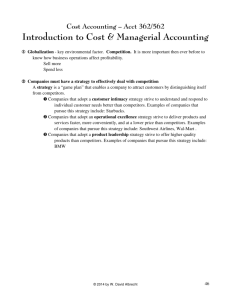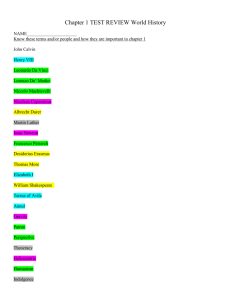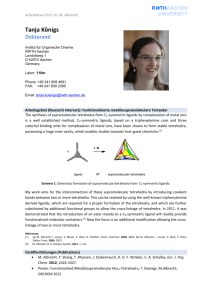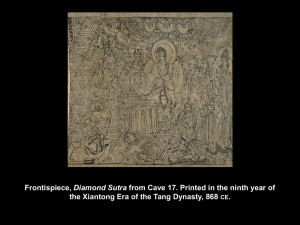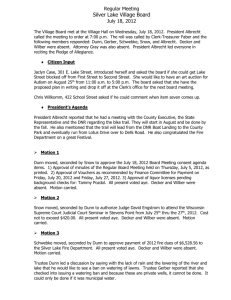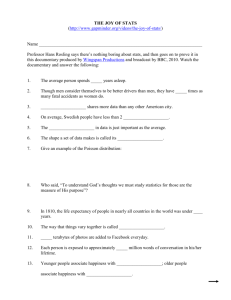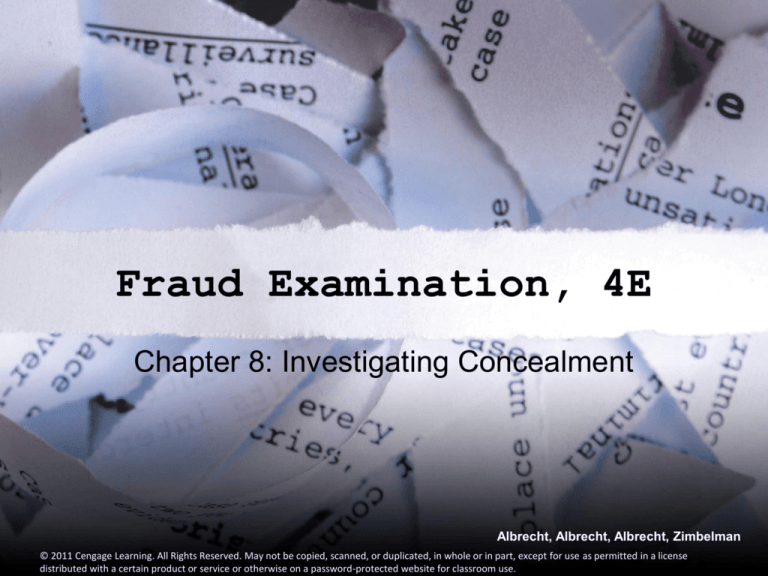
Fraud Examination, 4E
Chapter 8: Investigating Concealment
Albrecht, Albrecht, Albrecht, Zimbelman
© 2011 Cengage Learning. All Rights Reserved. May not be copied, scanned, or duplicated, in whole or in part, except for use as permitted in a license
distributed with a certain product or service or otherwise on a password-protected website for classroom use.
Learning Objectives
Describe concealment investigation methods and how
they relate to fraud.
Understand the value of documents and electronic records
in a fraud investigation.
List the different methods of obtaining documentary
evidence.
Understand how to perform discovery sampling to obtain
documentary evidence.
Explain how to obtain hard-to-get
documentary evidence.
Albrecht, Albrecht, Albrecht, Zimbelman
© 2011 Cengage Learning. All Rights Reserved. May not be copied, scanned, or duplicated, in whole or in part, except for use as permitted in a license
Concealment
Perpetrators must conceal their fraud by covering
their tracks, obscuring evidence, and removing
red flags where possible.
Accomplished by manipulating documentary
evidence
For an electronic perspective, concealment can
also be accomplished by modifying or deleting
records in corporate databases.
Albrecht, Albrecht, Albrecht, Zimbelman
© 2011 Cengage Learning. All Rights Reserved. May not be copied, scanned, or duplicated, in whole or in part, except for use as permitted in a license
Aspects of Documentary
Evidence
Unlike witnesses, documents do not forget, they
cannot be cross-examined or confused by
attorneys, they cannot commit perjury, and they
never tell inconsistent stories on two different
occasions.
Albrecht, Albrecht, Albrecht, Zimbelman
© 2011 Cengage Learning. All Rights Reserved. May not be copied, scanned, or duplicated, in whole or in part, except for use as permitted in a license
Aspects of Documentary Evidence
Albrecht, Albrecht, Albrecht, Zimbelman
© 2011 Cengage Learning. All Rights Reserved. May not be copied, scanned, or duplicated, in whole or in part, except for use as permitted in a license
Aspects of Documentary
Evidence
Investigators must understand the following
aspects of documentary evidence:
Chain of custody of documents
Marking of evidence
Organization of documentary evidence
Coordination of evidence
Rules concerning original versus copies of
documents
Albrecht, Albrecht, Albrecht, Zimbelman
© 2011 Cengage Learning. All Rights Reserved. May not be copied, scanned, or duplicated, in whole or in part, except for use as permitted in a license
Aspects of Documentary
Evidence
Chain of custody documents
Record must be kept of when a document is received and what
has happened to it since its receipt.
For computer-based evidence, professional programs like EnCase
and The Forensic Toolkit calculate checksums that support the
chain of evidence.
Albrecht, Albrecht, Albrecht, Zimbelman
© 2011 Cengage Learning. All Rights Reserved. May not be copied, scanned, or duplicated, in whole or in part, except for use as permitted in a license
Aspects of Documentary
Evidence
Marking the Evidence
A transparent envelope
should be used to store the
evidence, with the date
received and the initials of
the examiner written on the
outside.
A copy of the document
should be made, and the
original document should be
stored in the envelope in a
secure place.
Albrecht, Albrecht, Albrecht, Zimbelman
© 2011 Cengage Learning. All Rights Reserved. May not be copied, scanned, or duplicated, in whole or in part, except for use as permitted in a license
Aspects of Documentary
Evidence
Organization of the Evidence
Fraud cases can create tremendous amounts of
documentary evidence
In one case, 100 people worked full time for over a year to input key words
into a computer so that the documents could be called up on demand during
the trial—there were literally millions of documents.
Albrecht, Albrecht, Albrecht, Zimbelman
© 2011 Cengage Learning. All Rights Reserved. May not be copied, scanned, or duplicated, in whole or in part, except for use as permitted in a license
Aspects of Documentary
Evidence
Today, in especially large cases, it is not
uncommon to have electronic files of all
depositions and other testimony of all exhibits with
the testimony.
FBI’s Document Conversion Lab (DocLab)
Saves incredible amounts of time and space
Increases search capabilities exponentially
Enables information sharing far and wide
Albrecht, Albrecht, Albrecht, Zimbelman
© 2011 Cengage Learning. All Rights Reserved. May not be copied, scanned, or duplicated, in whole or in part, except for use as permitted in a license
Aspects of Documentary
Evidence
Evidence database should include the following:
Dates of documents
Sources of documents
Dates on which documents were obtained
Brief descriptions of document contents
Subjects of documents
Identifying or Bates number
Albrecht, Albrecht, Albrecht, Zimbelman
© 2011 Cengage Learning. All Rights Reserved. May not be copied, scanned, or duplicated, in whole or in part, except for use as permitted in a license
Aspects of Documentary
Evidence
Albrecht, Albrecht, Albrecht, Zimbelman
© 2011 Cengage Learning. All Rights Reserved. May not be copied, scanned, or duplicated, in whole or in part, except for use as permitted in a license
Aspects of Documentary
Evidence
Coordination of Evidence
Some investigations are simple and involve only a
few people.
Some investigations are large and involve
investigators, legal counsel, accountants, expert
witnesses, and management representatives. In
these type cases, investigation analysis software
can be useful.
Albrecht, Albrecht, Albrecht, Zimbelman
© 2011 Cengage Learning. All Rights Reserved. May not be copied, scanned, or duplicated, in whole or in part, except for use as permitted in a license
Aspects of Documentary
Evidence
Two popular investigation analysis software are:
Analyst’s Notebook14
Xanalys Link Explorer
Albrecht, Albrecht, Albrecht, Zimbelman
© 2011 Cengage Learning. All Rights Reserved. May not be copied, scanned, or duplicated, in whole or in part, except for use as permitted in a license
Aspects of Documentary
Evidence
Original Documents
versus Photocopies
Originals are preferable to
photocopies
In certain jurisdictions,
only four situations permit
photocopies
Albrecht, Albrecht, Albrecht, Zimbelman
© 2011 Cengage Learning. All Rights Reserved. May not be copied, scanned, or duplicated, in whole or in part, except for use as permitted in a license
Aspects of Documentary
Evidence
The original document has been lost or destroyed without
the intent or fault of the party seeking to introduce the
secondary evidence.
The original document is in the possession of an adverse
party who fails to produce it after a written notice to do
so, or when the party in possession is outside the
jurisdiction of the subpoena power of the court.
The document or record is in the custody of a public
office.
The original documents are too voluminous to permit
careful examination, and a summary of their contents is
acceptable.
Albrecht, Albrecht, Albrecht, Zimbelman
© 2011 Cengage Learning. All Rights Reserved. May not be copied, scanned, or duplicated, in whole or in part, except for use as permitted in a license
Aspects of Documentary
Evidence
Obtaining Documentary Evidence
The best way to obtain documentary evidence is
through computer-based queries of accounting
and other databases.
Another useful method of obtaining documentary
evidence is through traditional audits, including
discovery sampling.
Albrecht, Albrecht, Albrecht, Zimbelman
© 2011 Cengage Learning. All Rights Reserved. May not be copied, scanned, or duplicated, in whole or in part, except for use as permitted in a license
Aspects of Documentary
Evidence
Audits
Auditors conduct seven types of tests
Tests of mechanical accuracy (recalculations)
Analytical tests (tests of reasonableness)
Documentation
Confirmations
Observations
Physical examinations
Inquiries
Albrecht, Albrecht, Albrecht, Zimbelman
© 2011 Cengage Learning. All Rights Reserved. May not be copied, scanned, or duplicated, in whole or in part, except for use as permitted in a license
Aspects of Documentary
Evidence
Because gathering
documentation is a normal
part of their work, auditors
can often gather
documentary evidence as
part of an investigation
without arousing
suspicion.
Albrecht, Albrecht, Albrecht, Zimbelman
© 2011 Cengage Learning. All Rights Reserved. May not be copied, scanned, or duplicated, in whole or in part, except for use as permitted in a license
Aspects of Documentary
Evidence
Discovery Sampling
Discovery sampling is the easiest of all statistical sampling
variations to understand.
Albrecht, Albrecht, Albrecht, Zimbelman
© 2011 Cengage Learning. All Rights Reserved. May not be copied, scanned, or duplicated, in whole or in part, except for use as permitted in a license
Aspects of Documentary
Evidence
Documentation of Discovery Sampling
The investigator should document the method
used for determining sample size and the method
used for selecting the sample.
Evaluation of Errors
If the investigator finds errors, he or she must
determine whether the errors were unintentional
or are indicative of fraud.
Albrecht, Albrecht, Albrecht, Zimbelman
© 2011 Cengage Learning. All Rights Reserved. May not be copied, scanned, or duplicated, in whole or in part, except for use as permitted in a license
Aspects of Documentary
Evidence
Consideration of Nonsampling Risk
The investigator should also consider
nonsampling risk, which is the risk that a finding
will be misinterpreted.
Misinterpretation can be reduced by:
careful planning,
performance,
evaluation of the sampling procedure
Albrecht, Albrecht, Albrecht, Zimbelman
© 2011 Cengage Learning. All Rights Reserved. May not be copied, scanned, or duplicated, in whole or in part, except for use as permitted in a license
Aspects of Documentary
Evidence
Hard-to-Get Documentary Evidence
The most common examples are:
Web-based e-mail accounts
Private bank records
Tax returns
Brokerage records
Albrecht, Albrecht, Albrecht, Zimbelman
© 2011 Cengage Learning. All Rights Reserved. May not be copied, scanned, or duplicated, in whole or in part, except for use as permitted in a license
Aspects of Documentary
Evidence
Hard-to-Get Documentary
Evidence
Three ways to obtain
documentary evidence:
Subpoena
Search warrant
Voluntary consent
Albrecht, Albrecht, Albrecht, Zimbelman
© 2011 Cengage Learning. All Rights Reserved. May not be copied, scanned, or duplicated, in whole or in part, except for use as permitted in a license
Aspects of Documentary
Evidence
Document Experts determine whether…
a document was written by the person whose signature it
bears
a document has been forged
a document has been altered by additives, deletions,
obliterations, erasures, or photocopying
the handwriting is genuine
the entire document was printed on the same machine
a document was printed on the date it bears or before or
after
two or more documents are significantly different or
substantially the same
pages have been substituted in a document.
Albrecht, Albrecht, Albrecht, Zimbelman
© 2011 Cengage Learning. All Rights Reserved. May not be copied, scanned, or duplicated, in whole or in part, except for use as permitted in a license
Aspects of Documentary
Evidence
Two well-known
organizations of document
experts can offer in fraud
investigations.
FBI: Questioned Documents
Section of the Forensic
Analysis Section
American Board of Forensic
Document Examiners, Inc.
Albrecht, Albrecht, Albrecht, Zimbelman
© 2011 Cengage Learning. All Rights Reserved. May not be copied, scanned, or duplicated, in whole or in part, except for use as permitted in a license


